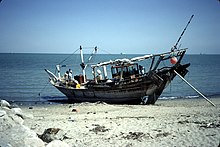| DrHessa al-Rifa'i | |
|---|---|
| Born | 1947 |
| Citizenship | Kuwait |
| Education | Indiana State University |
| Employer | Kuwait University |
Hessa al-Rifa'i (Arabic: حصة الرفاعي) (born 1947) is a folklorist and poet from Kuwait.
Biography
Al-Rifa'i was born in Kuwait City in 1947. She studied for a BA in Arabic at Cairo University. She was awarded an MA in Folk Literature in 1971. She then went on to study for a PhD at Indiana State University, which she was awarded in 1982. In it she studied the impact of modernisation on the folk traditions of Kuwait.
Since 1982, al-Rifa'i has worked as a professor in the Department of Arabic Language at Kuwait University. Her poetry and her research are published in both English and Arabic.
She lives in Kuwait.
Folklore Studies

Al-Rifa'i is an expert in the culture and history of sea-songs and shanties, from Kuwait and the Persian Gulf region. She studied has studied their musical structure, demonstrating that they follow Arabic melodic structures. She has also studied the movement of Arabic musical traditions across the Mediterranean to Andalusia. As well as the musical heritage of sea-shanties, al-Rifa'i has studied the cultural practices that go alongside: for example women performing rituals, such as placing a bar of hot iron in the sea, to ensure the safe return of fishermen. In addition, al-Rifa'i studies comparative folk literature, including the Cinderella narrative in Kuwaiti tradition. She has worked on the legacy of the folk-poet Zaid Al-Harb.
Poetry
Al-Rifa'i is a poet herself and has published four books of poetry.
References
- ^ "حصة الرفاعي". 2019-03-27. Archived from the original on 2019-03-27. Retrieved 2020-03-29.
- "AL-NEHMAH WAL-NAHHAM: A STRUCTURAL, FUNCTIONAL, MUSICAL AND AESTHETIC STUDY OF KUWAITI SEA SONGS". www.elibrary.ru. Retrieved 2020-03-29.
- صخر, محمد الشارخ-. "أرشيف المجلات الأدبية والثقافية". archive.alsharekh.org (in Arabic). Retrieved 2020-03-29.
- "Folklore and the Issue of Terminology" (in Arabic)". pubcouncil.kuniv.edu.kw. Retrieved 2020-03-29.
- Ulaby, Laith (2008). Performing the past: Sea music in the Arab Gulf states (PhD in Ethnomusicology thesis). University of California, Los Angeles=. ProQuest 304653749.
- ^ Ulaby, Laith (2012). "On the Decks of Dhows: Musical Traditions of Oman and the Indian Ocean World". The World of Music. 1 (2): 43–62. ISSN 0043-8774. JSTOR 24318118.
- Al-Rifai, H. (1987). "Cultural and Historical Features of Kuwait Sea Song Music". Proceedings of the Seminar for Arabian Studies. 17: 143–162. ISSN 0308-8421. JSTOR 41223052.
- Frishkopf, Michael Aaron, ed. (2010). Music and media in the Arab world (1st ed.). Cairo: The American University in Cairo Press. p. 125. ISBN 978-977-416-293-0. OCLC 687918320.
- "Umi Smaika-Cinderella Comparative Study in Fairy Tales". apc.ku.edu.kw. Retrieved 2020-03-29.
- "Zaid Al-Harb and Touching the Nations Strings". apc.ku.edu.kw. Retrieved 2020-03-29.